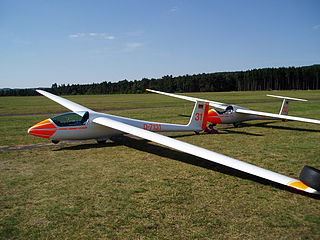Related Research Articles

The DFS 230 was a German transport glider operated by the Luftwaffe in World War II. It was developed in 1933 by the Deutsche Forschungsanstalt für Segelflug with Hans Jacobs as the head designer. The glider was the German inspiration for the British Hotspur glider and was intended for airborne assault operations.

The Glaser-Dirks DG-400 is a single-seat self-launching motorglider that was produced by Glaser-Dirks between 1981 and 1992. It was the first self-launching motorglider with retractable engine and propeller to be produced in large numbers.

The ASW 19 is a single-seat glider built by Alexander Schleicher GmbH & Co, first flying in 1975. It was originally designed as a Standard Class glider, but now mainly competes in the Club Class. The ASW 19 is known for its pleasant handling and some clubs use it as a training glider. It was succeeded by the all-new Schleicher ASW 24.

The LET L-23 Super Blaník is a two-seat, all-metal structure glider with fabric covered control surfaces. The aircraft is primarily used for flight training; its single-seat sister model is the Let L-33 Solo.

The Baynes Bat was an experimental glider of the Second World War, designed by L. E. Baynes. It was used to test the tailless design that he had suggested as a means to convert tanks into temporary gliders so they could be flown into battle.

The Valmet PIK-23 Towmaster or Suhinu is a Finnish two-seato glider towing/primary trainer aircraft built entirely out of composite materials in the early 1980s.
The LWD Żak was a Polish touring and trainer aircraft of the late 1940s, designed in the LWD and built in a short series.

The Cessna Model CG-2 was a 1930s American primary glider built by the Cessna Aircraft Company.

The Schleicher ASK 23 is a single-seat Club Class sailplane that was built by the German manufacturer Alexander Schleicher GmbH & Co.
The Flight Dynamics Flightsail VII was a recreational aircraft marketed in the United States in the 1970s for homebuilding by Flight Dynamics, Inc., most unusual both in its design and its method of construction. The Flightsail VII was intended to be built in three stages, with each stage representing a flyable aircraft of increasing complexity, capability, and cost. It was hoped that this approach would appeal to homebuilders by minimizing the amount of time and money required to take the aircraft to a point where it could be flown.

The Hafner Rotabuggy and as the "M.L. 10/42 Flying Jeep" was a British experimental aircraft that was essentially a Willys MB combined with a rotor kite, developed with the intention of producing a way of air-dropping off-road vehicles.

The Scheibe SF 34 Delphin is a two-seat sailplane that was produced by Scheibe in Germany in the late 1970s and 1980s. Designed by Wolf Hoffmann and originally designated the SF H34, it was Scheibe's first unpowered aircraft of composite construction.
The Shenyang X-9 Jian Fan is a Chinese training glider built by the Shenyang Sailplane Factory at Shenyang.

The Glaser-Dirks DG-600 is a glider manufactured by Glaser-Dirks as a successor to the DG-202 and DG-400 series of gliders where carbon fiber reinforced plastics was used.
The Explorer PG-1 Aqua Glider is an American single seat, biplane glider that was designed by Bill Skiliar in 1959 and made available as plans for amateur construction. The prototype was built with help from a troop of Air Explorer Scouts that same year.

The WACO primary glider or simply WACO glider, was an early product of the Waco Aircraft Company. The low cost glider was intended to be flown from low hills or towed by a vehicle.

The Peel Z-1 Glider Boat, also called the Peel Flying Boat, is an American biplane, two-seats-in-tandem, flying boat glider that was designed and produced by the Peel Glider Boat Company, starting in about 1930.

The ProFe D-8 Moby Dick is a family of Czech pusher configuration, parasol wing, strut-braced, V-tailed, motor gliders that was designed and produced by ProFe. The aircraft is named for the great white whale of Herman Melville's novel of the same name and was supplied as a kit for amateur construction.
The Ryson STP-1 Swallow is an American experimental two-seat powered cruising sailplane designed and built by the Ryson Aviation Corporation to be license built by other companies.
The Bailey-Moyes Tempest, is an Australian-American high-wing, strut-braced, single-seat, microlift glider that was designed by Bob Bailey of Florida, United States and produced by Moyes Microlights of Waverley, New South Wales, Australia.
References
- Taylor, Michael J. H. (1989). Jane's Encyclopedia of Aviation. London: Studio Editions. p. 352.
- Hardy, Michael (1982). Gliders and Sailplanes of the World. Shepperton: Ian Allan. p. 38.
- AirVenture Museum website